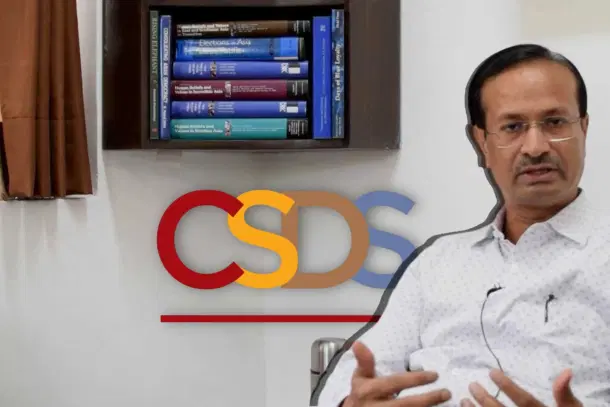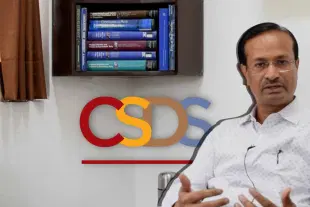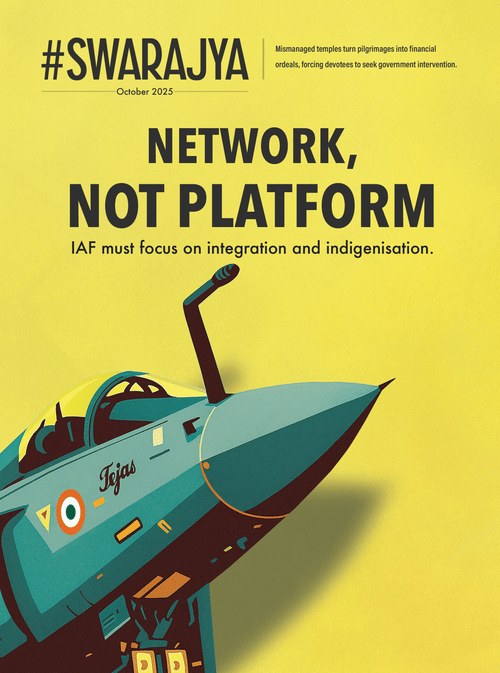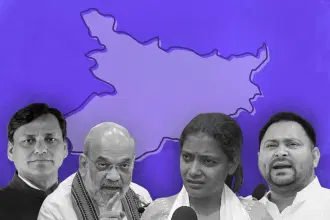Politics
When Numbers Become Narratives: How Politicised Polling Is Manufacturing A Credibility Crisis
Nabaarun Barooah
Sep 01, 2025, 02:31 PM | Updated 02:30 PM IST
Save & read from anywhere!
Bookmark stories for easy access on any device or the Swarajya app.


In the closing weeks before the Bihar elections, Rahul Gandhi stood on a stage in Nawada and thundered about democracy itself being stolen. "Vote Chori ho rahi hai," he declared to the crowd, waving a slip of paper that he claimed was "proof."
His campaign's new website invited citizens to sign up via missed call and download a certificate declaring themselves defenders of the ballot. Alongside, his Voter Adhikar Yatra, a 1300-kilometre march across twenty districts of Bihar, was framed as a battle to protect "one man, one vote" from the alleged manipulations of the Election Commission.
For the Congress, this campaign was not simply a clever slogan. It was a strategy of election denialism. Every election setback, every seat lost, every defeat, large or small, could now be laid at the door of electoral theft. The vote itself, not the message or the leadership, became the object of suspicion.
The Election Commission responded with rare bluntness. The phrase Vote Chori, Chief Election Commissioner Gyanesh Kumar argued, was not mere political hyperbole but a "dirty phrase" and an attack on the Constitution itself. The EC demanded that Rahul Gandhi furnish evidence, in the form of a sworn affidavit or else withdraw his charge.
Caught in the crossfire was an institution that once epitomised academic credibility in Indian democracy: the Centre for the Study of Developing Societies (CSDS).
A few weeks earlier, CSDS had issued clarifications and even apologised for misrepresentations of its data, after sections of Rahul's campaign seemed to rely on it as supporting evidence. This triggered an official showcause notice from the Indian Council of Social Science Research (ICSSR), questioning the academic neutrality of one of India's premier research centres.
The larger story, however, goes beyond Rahul Gandhi's theatrics or the EC's rebuttal. It is about the place of numbers in India's democracy. For decades, survey data and polling were treated as mirrors of popular will, a way to bring scientific rigour to the electoral process. Today, numbers are no longer neutral. They are narratives, weaponised in the service of political legitimacy or denial. In this transformation lies a deeper crisis for Indian democracy.
Indian Psephology from Numbers to TRP
The story of polling in India began in the 1960s as a scholarly exercise in understanding how the world's largest democracy actually voted.
At the forefront was the Centre for the Study of Developing Societies, founded in 1963 in Delhi by political theorist Rajni Kothari. CSDS soon became home to the Lokniti Programme, a network of scholars that pioneered election studies in India.
Their surveys of voter behaviour, painstakingly collected from booths and villages across the country, provided a window into the functioning of democracy at a scale unseen anywhere else.
In the early decades, psephology in India carried an aura of neutrality. It was the meeting point of statistics, sociology, and political science, where numbers were carefully interpreted to explain not only who won but why.
Voter surveys illuminated how caste, class, gender and region shaped political preferences. They tracked the decline of the Congress system, the rise of regional parties, and the first stirrings of a BJP-led alternative in the 1980s. As a student of political science myself, CSDS surveys were the gold standard of studying voter behaviour in India.
However, parallel to the academic world, television was beginning to take an interest. Prannoy Roy, an economist turned pollster, brought psephology to prime-time in the 1980s with the India Today–ORG polls and later with NDTV's election specials.
His data-driven presentations, accompanied by the gravitas of Ashok Lahiri, introduced a generation of Indians to the science of electoral prediction. Roy's graphics and charts became part of the election-night ritual.
What united both CSDS and the early NDTV polls was a shared ethos: numbers were meant to reveal, not to spin. They were not perfect: the sample sizes were small, the predictions often off-mark, but they were respected as honest attempts to capture the pulse of the electorate.
By the 1990s, psephology had acquired legitimacy as a field in itself. Yogendra Yadav, a leading figure in CSDS and later in Lokniti, expanded the reach of election studies. His surveys went beyond the arithmetic of vote shares to examine the sociology of democracy. Yadav's work on the "second democratic upsurge," the empowerment of backward classes and marginalised groups through the ballot, became part of the mainstream academic understanding of Indian politics.
For nearly four decades, then, Indian psephology enjoyed a reputation for seriousness. It was seen as a scientific bridge between citizens and the state, a way to understand how the world's most complex electorate made its choices. The numbers, while imperfect, were trusted.
That trust, however, would not last. As television exploded and political competition intensified, numbers began to leave the pages of journals and the quiet halls of CSDS, and enter the charged arena of electoral theatre. The line between science and spectacle began to blur.
The 1990s inaugurated the age of the television pollster. The liberalisation of India's economy coincided with the explosion of satellite television, and newsrooms suddenly found themselves with a new weapon to capture eyeballs: the exit poll. What began as cautious, data-driven estimates soon turned into prime-time theatre, designed less to illuminate and more to entertain.
Methodological discussions about sampling, margins of error, and regional variations quietly slipped backstage. What took centre stage was the drama of projection: "Who will form the next government? Tune in at 9!" Exit polls became less about explaining voter behaviour and more about creating suspense, sustaining the illusion that the nation's fate would be revealed not through ballots but through a televised guessing game.
Commercialisation accelerated the trend. Media houses were quick to realise that numbers, when packaged with ticker graphics and breathless anchors, could drive ratings. Political parties, equally astute, saw in these surveys an opportunity, not to understand the voter, but to shape perception. A poll showing a party ahead could demoralise opponents, boost cadre morale, and sway undecided voters. Soon, whispers of "planted polls" and "agenda-driven surveys" became commonplace.
The credibility gap widened further as consultancies with opaque methodologies mushroomed, offering ready-made surveys to whoever could pay. Polling moved from university corridors to hotel conference rooms, from academic reports to flashy PowerPoint decks. Unlike CSDS, which still clung to scholarly rigour, many of these entities thrived on speed and spectacle.
By the early 2000s, even seasoned journalists admitted that election coverage had become less about reporting ground realities and more about playing armchair psephologists in studios. Poll numbers were no longer tools of analysis, they were weapons of propaganda. The audience, meanwhile, learned to consume them as entertainment, no more reliable than a weather forecast.
In this transformation, the scholarly lineage of psephology was sidelined. India had entered the era of political polling as mass entertainment, where accuracy was secondary, and spectacle was the only currency that mattered.
CSDS in the Crossfire
In this noisy landscape, CSDS tried to hold on to its reputation as the country's premier academic polling institution. For decades, it had been the gold standard, seen as above the political fray. But as psephology itself became politicised, CSDS could no longer escape scrutiny. Its carefully calibrated numbers began to be pulled into partisan battles, cited selectively and attacked ferociously.
The row began on 18th August 2024, when Congress spokesperson Pawan Khera posted a graphic on X (formerly Twitter) claiming huge discrepancies in the Lok Sabha and Maharashtra Assembly voter rolls. Citing Sanjay Kumar and Lokniti-CSDS data, Khera alleged that constituencies such as Ramtek and Deolali had seen their electorate dwindle by almost 40% in just six months, while others like Nashik West and Hingna recorded improbable jumps of more than 40%.
A day earlier, on 17th August, Sanjay Kumar himself had posted numbers suggesting bizarre spikes in the voter rolls of Nashik West and Hingna, claiming a 47% and 42% increase in voters, respectively. His figures quickly spread across social media and were amplified by opposition leaders to question the credibility of the Election Commission.
But within 48 hours, on 19th August, Kumar deleted his post and issued a public apology. He admitted the data was wrong, attributing the error to his "data team" misreading rows in the datasets. He stressed that there was "no intent to spread misinformation." Yet, by then, the damage was done. His numbers had already circulated widely, feeding narratives of election manipulation and denting the credibility of the Election Commission in the eyes of the public.
Independent fact-checkers confirmed that Kumar's claims were grossly inflated. Official Election Commission data showed that Nashik West had seen a modest rise of about 6% around 27,400 voters not the massive jump of 1.5 lakh that Kumar claimed. Similarly, Hingna's increase was closer to 25,000 voters, not the 43% surge he reported.
This raises uncomfortable questions. Was the episode a case of deliberate political mischief or an extraordinary lapse in research integrity at one of India's premier social science institutions? If the latter, why was a taxpayer-funded body at the centre of a controversy that effectively fuelled election denialism and handed ammunition to a political party against a constitutional body?
At stake is not merely one scholar's reputation but the institutional credibility of CSDS itself. With nearly half its funding, INR 4.51 crore out of INR 9.9 crore, coming from the ICSSR, i.e., from the public purse, CSDS is expected to operate above partisan politics. Instead, one of its leading figures has left the institution open to charges of bias, sloppy scholarship and worse: of undermining democratic institutions through misinformation.
The Congress, for its part, has leaned heavily on CSDS figures to buttress its latest campaign: "Vote Chori." Gandhi and his party argue that statistical patterns, turnout anomalies, and CSDS projections show evidence of systematic rigging in the 2024 general elections. What might once have been an internal debate within the social sciences has thus become fodder for an opposition narrative that delegitimises India's electoral process itself.
Whether or not CSDS survives this storm intact, the episode marks a decisive shift. Psephology in India has fully crossed from the realm of scholarship into the realm of political combat. The numbers are no longer just numbers, they are battle standards in a war of narratives.
Vote Chori as Data Politics and the Credibility Crisis of Polling
If there is one thing the Congress party under Rahul Gandhi has mastered in the last year, it is the politics of data without the responsibility of accuracy. His "Vote Chori" campaign is not merely a slogan but a structured political programme designed to build a narrative of electoral theft.
The campaign's architecture rests on three visible pillars. First is the digital ecosystem: a dedicated website, a missed-call number for supporters to register their grievance, and downloadable certificates declaring that the individual stands against "stolen votes." By transforming grievance into a badge of identity, Congress is attempting to replicate the viral mobilisation strategies seen in the Trump-era United States, where "Stop the Steal" became a movement unto itself.
Second is the physical mobilisation: the so-called Voter Adhikar Yatra, a 1300 km march across 20 districts, pitched as a mass awakening against alleged manipulation. In speech after speech, Rahul Gandhi and his lieutenants point to alleged voter deletions, mysterious spikes in certain constituencies and suspicious transfers of voters. Their "proof," however, often comes not from the Election Commission but from contested surveys, social media infographics or selectively quoted figures from bodies like CSDS.
Third is the discursive strategy: to shift the debate from specific grievances to systemic delegitimisation. Every roll revision becomes "manipulation," every discrepancy becomes "proof" of theft and every critical fact-check is brushed aside as propaganda. The aim is not to demonstrate fraud beyond doubt but to seed enough doubt that the very legitimacy of the Election Commission is questioned.
Unsurprisingly, the Election Commission has responded with rare aggression. It has demanded affidavits from those making sweeping allegations, even hinting at criminal action against deliberate misinformation. Yet the damage is already done: in the public imagination, numbers once treated as dry data are now battlefield weapons.
The larger issue here is not whether deletions or errors occur. They do, and often disproportionately affect migrant or marginal communities. The issue is how these imperfections are weaponised. Numbers are no longer presented as evidence to be debated; they are deployed as ammunition to delegitimise an entire electoral system.
In this sense, Rahul Gandhi's campaign mirrors the global playbook of election denialism. Donald Trump in the United States, Jair Bolsonaro in Brazil and a slew of other populists have all drawn on the same tactics: converting technical anomalies into political dynamite, mobilising grievance into mass movements and framing the very act of losing an election as evidence of theft.
For Indian democracy, the danger is not just reputational but structural. A polity where every electoral verdict is contested as "Vote Chori" risks sliding into chronic instability. Once faith in the referee collapses, no result can command legitimacy and politics degenerates into permanent suspicion.
The "Vote Chori" saga also shines a harsh light on the state of India's polling and survey ecosystem. Once regarded as a domain of scholarship, polling today is increasingly viewed as a theatre of bias. Accusations of "paid surveys," "agenda-driven projections," and "planted polls" are now common parlance in political debate.
Polling was always an imperfect science, but it functioned on the assumption that public trust in the intent of pollsters remained intact. That trust has now eroded. Every major outfit, from CSDS to private firms, faces questions of neutrality.
When survey numbers align with one side's narrative, they are hailed as truth; when they contradict, they are dismissed as propaganda. This constant weaponisation has created an atmosphere in which no dataset, however rigorous, can stand uncontested.
The consequence is corrosive. Citizens, already sceptical of media, now view polls with the same suspicion. The serious function of polling such as diagnosing voter priorities, identifying policy gaps and providing feedback to the political system is drowned out in the din of denialism. Instead of spurring reform (such as addressing genuine roll errors or improving EVM transparency), the debate devolves into slogans of "rigged" and "stolen."
The credibility crisis is not just academic; it shapes the lived experience of democracy. If voters come to believe that surveys are merely extensions of political propaganda, then both polling and the institutions it interacts with the Election Commission, academic bodies and even the courts lose legitimacy by association.
In that sense, the crisis of polling is inseparable from the crisis of democracy itself. The numbers, once trusted as a mirror of the electorate, are now perceived as instruments of manipulation. And in the absence of trust, even the most transparent process risks being dismissed as a fraud.
Democracy Beyond Data
The obsession with numbers in modern electoral politics must be understood against the civilisational backdrop of Bharat's democratic heritage.
The Indic tradition of governance did not reduce legitimacy to tallying heads or crunching percentages. Ancient institutions like the sabhas, ganas and samitis were built on a principle of consensus-seeking, where the emphasis was on trust, dialogue and dharmic order, rather than the arid mathematics of majorities. Kingship itself was often tempered by council deliberations and rulers drew their authority not merely from numerical superiority but from recognition of their alignment with dharma.
The danger of today's "Vote Chori" discourse is that it weaponises numbers in a way that corrodes this civilisational ethos. When voter rolls, surveys and projections are manipulated or misread and then broadcast as evidence of systemic theft, the underlying trust between citizens and institutions is eroded. Democracy is no longer seen as a shared dharmic compact, but as a zero-sum game of "us versus them."
Over-reliance on contested data risks turning elections into permanent battlegrounds of suspicion. Numbers, when stripped of their dharmic grounding, lose legitimacy; they become slogans rather than symbols of truth.
A society that ceases to trust the processes of representation and begins to see only manipulation cannot sustain the delicate fabric of self-rule. In that sense, Bharat's civilisational democracy is undermined not by contested votes alone, but by the very idea that truth itself can be reduced to disputable statistics.
The current row over CSDS, the Election Commission, and Rahul Gandhi's "Vote Chori" campaign reveals something larger than an institutional spat: it shows how fragile public trust in numbers has become. In a healthy democracy, data is supposed to illuminate reality, to guide debate and to govern better. Instead, it is increasingly deployed as ammunition, selectively cited, distorted or sensationalised to fuel political battles.
Restoring faith in numbers requires three urgent correctives. First, transparent methodology must be non-negotiable whether in polling, voter lists or surveys. Academic institutions, no matter how reputed, must open themselves up to public scrutiny. Citizens should be able to trace how data was collected, sampled and interpreted.
Second, there is a need for independent audits, where neutral bodies regularly verify the claims of both state institutions and research organisations. Third, and most importantly, data must be understood within Bharat's civilisational frame where legitimacy flows from dharma and trust, not mere statistical arithmetic. Numbers must serve as reflections of a lived political reality, not tools for its manufacture.
If these safeguards are not instituted, then surveys, exit polls and voter statistics will be reduced to little more than slogans. Every defeat will be painted as theft, every anomaly as conspiracy and every dataset as partisan propaganda. That is a recipe not just for declining faith in institutions, but for a hollowing out of democracy itself. For democracy to thrive, truth must stand above numbers, and numbers must serve truth and not distort it.





